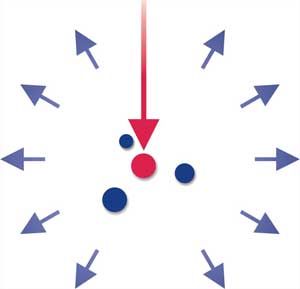| Posted: March 19, 2007 |
Smallest laser possible consists of only two atoms |
|
(Nanowerk News) The run on even smaller equipment and even smaller lasers does not seem to end. Or does it? According to researchers at the FOM Institute for Atomic and Molecular Physics (AMOLF) in Amsterdam it is possible to have lasers that consist of only two atoms. They will soon have their findings published in the scientific journal Physical Review Letters " Gain Narrowing in Few-Atom Systems".
|
 |
| Theoretically, only a few atoms are sufficient to form a laser. One of the atoms (red) is in a higher energy position. This atom will emit a photon at a regression into a lower energy position. The other atoms (blue) together act as a mirror and reflect the photon. Further scattering of photons in this system provides for a stimulated emission. The light that the atoms emit collectively, is laser light. (Image: FOM)
|
|
t is possible to make even smaller lasers, but it will stop eventually. Theoretical physicists dr. Tom Savels (AMOLF), professor Ad Lagendijk (AMOLF and University of Twente) and dr. Allard Mosk (University of Twente) proved this possibility. Their - theoretical - research shows that lasers consisting of a cluster of five atoms are able to function very well and that even a cluster of two atoms will be sufficient to form a laser system. Continually, one of the atoms is being 'pumped' that means, charged with energy; the other one acts as a 'mirror' and provides feedback. Macroscopic mirrors or vibrating cavities are not needed in order to be able to observe the working of the laser.
|
|
Limit
|
|
The basic assumption of the researchers was: what actually is the limit? What is the smallest number of atoms possible needed to build a laser? Ten, twenty or more? This is an issue within the scope of the continual technical breakthroughs that makes miniaturization possible and that is the search for increasingly small light sources. Scaling down of laser systems makes it possible to integrate lasers into more and more complex systems. At first, Lagendijk and Savels thought that the magic limit would be much higher, but to their surprise it just turned out to be a cluster of two atoms.
|
|
To restore peace and quiet
|
|
A laser is distinct from 'common' light or LED light within the meaning that laser light dominates in one colour as the light becomes more intensive. Savels found in his research that this dominance increases as the number of atoms is higher. This finding restored the peace in the ranks of the researchers, where so far - in the absence of the right definition - there had not been any consensus about the exact nature of a laser. The past few years Savels, Lagendijk and Mosk have been attending many scientific conferences, which their colleague researchers were agreeing on large lasers, but which they were terribly disagreeing on small lasers. The doctoral research by Savels comprehends a proposal to a consensus: something is a laser if the dominance of one colour increases, when adding more energy.
|
|
Experiments
|
|
This research may contribute on two fronts. The working of the laser that is being predicted, does not only apply for atoms, but also for a wide range of microscopic objects, such as quantum dots (artificial atoms), molecules of DNA-chains and, thus, it will be able to provide for important experiments and applications. In addition to this, the research may gain an insight into the processes that control the laser dynamics at a microscopic scale in order to optimize further technological miniaturization.
|

